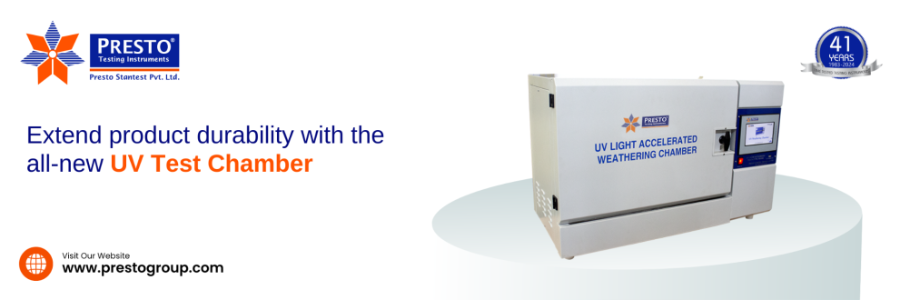

UV test chambers are particularly valuable in the car, aerospace, and electronics industries. The chamber simulates UV radiations, allowing the tester to see how the material would perform when exposed to severe sunshine.
The UV test chamber creates controlled conditions in which samples are exposed to UV radiation. It aids in predicting the material’s long-term durability, color stability, and overall performance.
Applications for UV Test Chambers
UV test chambers are widely used in several main industries:
Materials: To understand different materials like polymers, coatings, and textiles - it is very useful to use this device so that you can research their specific applications as well.
Developing items: Manufacturers use UV chambers to improve the composition and design of paints, adhesives, and outdoor equipment. This testing ensures that items meet performance objectives and client expectations, as stated by Hill et al. (2015).
Controlling quality: If you want to ensure that you comply with industry standards without any hassle - the best way is to use a UV tester - they are used in industries like aerospace to elongate the lifespans of their devices, especially components exposed to sunlight frequently, according to Schmidt et al. (2018).
Calibration ensures accurate and reliable UV test findings. Key features of calibrating include:
1. Radiometer: UV chambers have radiometers that correctly measure UV intensity. Regular calibration of this equipment guarantees that UV exposure levels are consistent and dependable, as defined by ASTM International standards (ASTM G173).
2. Temperature and Humidity Control: UV chambers frequently use precise temperature and humidity control to imitate realistic environmental conditions. Calibration of these factors ensures consistent testing circumstances and outcomes.
3. Uniformity of Exposure: Obtaining reliable test results requires uniform UV exposure across the whole test region. Smith et al. (2017) highlight how chamber design and periodic validation tests help maintain consistent testing conditions.
APPLICATIONS:
1. Automotive industry: UV chambers are used for testing the UV resistance of coatings, and interior materials. This testing is important for maintaining colorfastness and aesthetic appeal (Ford, 2021).
2. Electronics: UV testing assesses the durability of electronic components, circuit boards, and other materials that are frequently exposed to sunlight. It helps to ensure that these components perform consistently in outside scenarios.
3. Cosmetics: They are used to assess the durability of cosmetics and pharmaceuticals under UV radiation. This testing is essential for maintaining product quality and durability.
FAQS:
Q1) What are the advantages of material testing?
Answer: Furthermore, UV testers provide a substantial contribution to product development by providing early feedback on formulas and designs. Manufacturers can improve their products by finding weaknesses or vulnerabilities that allow them to meet demanding performance criteria and regulatory constraints. Finally, the use of UV testers improves quality control methods, encourages material science innovation, and ensures product reliability when exposed to UV radiation.
Q2) How does calibration ensure precision?
Answer: Calibration is essential for ensuring the accuracy and reliability of UV testers in delivering consistent test results. The UV weathering chamber goes through rigorous calibration procedures to evaluate and alter crucial parameters that affect testing conditions and measurements.
Firstly, radiometer calibration is required since UV testers use radiometers to precisely detect UV intensity. Regular calibration ensures that these instruments accurately monitor UV levels within the chamber. This step is critical for preserving consistency in test results and ensuring that samples get the appropriate UV radiation levels.
Second, calibration of temperature and humidity controls is required to simulate actual environmental conditions within the UV tester. These parameters have a substantial impact on material behavior and reactions to UV exposure. Thus, careful calibration of temperature and humidity settings ensures that the test circumstances are suitable.
Q 3) How do UV testers contribute to enhancing product durability and reliability?
Answer: UV testers are useful in businesses that want to improve the endurance and reliability of items exposed to real-world UV radiation. These chambers create controlled environments in which materials and products are rigorously tested to determine their resistance to UV radiation, which is an important component impacting their long-term performance in outdoor situations.
UV testing has the fundamental advantage of being able to anticipate and analyze the deterioration processes caused by long-term sunlight exposure. UV testers, for example, are used in aerospace to test the durability of composite materials used in aircraft components. Engineers can identify potential flaws and modify materials to resist the harsh conditions of high-altitude operations by simulating UV exposure.
What are you waiting for? Get the UV environmental test chamber right now! Reach out to us through a phone call at +91 9210903903 or directly dropping us an e-mail at info@prestogroup.com.
Connect with us for your business enquiries. Generally, we respond within one or two working days.